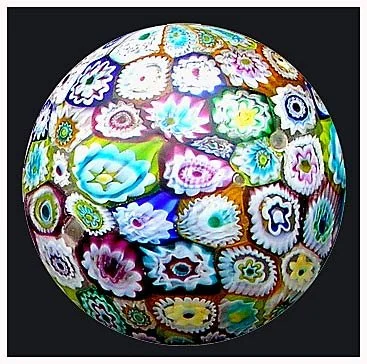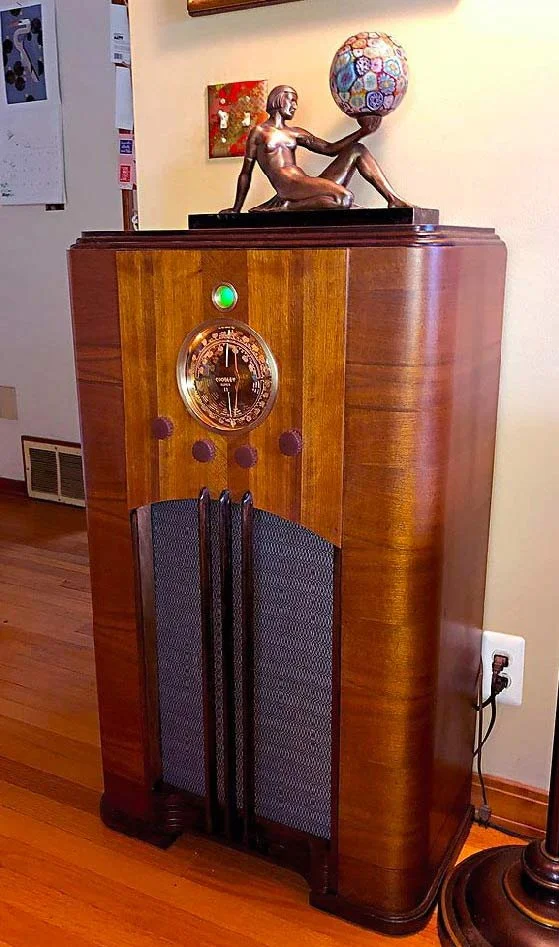Art Deco Figurine Lamp
This lamp was made in 1907 by the J.B. Hirsch Company in New York City. She is a bronze-plated lady holding a delicate Millefiori globe—a striking example of early 20th-century craftsmanship.
My grandparents originally purchased the lamp and later passed it down to my mother. It lived in my childhood home for as long as I can remember. I always knew it was the one item I truly wanted—hoping my brothers felt otherwise. One day, out of the blue, my father asked if I wanted to take it home. YES! And just like that, it became mine.
This was long before I began exploring Art Deco in my own work, but somehow, this lamp was always meant to be part of my life.
Today, she proudly rests atop my restored 1938 Crosley radio, a perfect pairing of elegance and history.
Years later, when I was commissioned to build a custom Art Deco dining set for a client, I looked over at that lamp. I thought of my love for the Chrysler Building—and I realized my future was already in motion. Art Deco wasn’t just a style I admired; it was the direction my life was always meant to follow.
Notes:
Millefiori: A decorative glasswork technique with roots in antiquity, Millefiori—Italian for “a thousand flowers”—was perfected by Murano glassmakers in the 19th century. The process involves fusing rods of colored glass, stretching and slicing them into cross-sections, and embedding the intricate slices into objects like vases, beads, and globes.
The J.B. Hirsch Company: Founded in 1907 by Joseph and Abraham Hirsch in New York City, this renowned American company became known for its "French Bronzes"—sculptures cast from 19th-century French molds. Their work, often in Art Nouveau and Art Deco styles, remains prized for its quality and elegance.
Relatives















Joel Liebman Custom Art Deco Furniture
History of Art Deco Furniture
Art Deco furniture emerged in the early 20th century, flourishing in the 1920s and 1930s as a luxurious, modern design movement. It was characterized by bold geometric patterns, streamlined forms, and lavish materials. The style gained prominence at the 1925 Exposition in Paris, where designers showcased sleek, sophisticated furniture that departed from the ornate curves of Art Nouveau.
Woods Used in Art Deco Furniture
Craftsmen utilized exotic and high-quality woods to enhance the rich aesthetic of Art Deco furniture. Some of the most common woods included:
Macassar Ebony – A dark, striped wood with a dramatic, high-contrast grain, often used for veneers.
Walnut – A warm-toned wood favored for its rich grain and versatility.
Mahogany – A deep reddish-brown wood, commonly used for its durability and luxurious appearance.
Zebrawood – A strikingly striped wood that added bold, decorative patterns.
Rosewood – A dark, richly grained wood that brought an exotic flair to furniture pieces.
Sycamore & Maple – Lighter woods often used for contrast in inlays and decorative marquetry.
The use of lacquer, metal inlays, and exotic materials such as ivory and shagreen (stingray skin) further emphasized the elegance and sophistication of Art Deco furniture.
By the 1940s, the rise of World War II and changing tastes led to the decline of Art Deco, but its influence remains strong in contemporary luxury interiors. Today, original Art Deco pieces and modern interpretations continue to be sought after for their timeless elegance and craftsmanship.
Several designers and furniture makers played a significant role in shaping the Art Deco movement. Here are some of the most famous names associated with Art Deco furniture:
Émile-Jacques Ruhlmann (1879–1933)
Often considered the master of Art Deco furniture, Ruhlmann was known for his elegant designs using exotic woods like Macassar ebony, rosewood, and mahogany. His work featured refined lines, delicate marquetry, and luxurious materials such as ivory inlays.
Jean Dunand (1877–1942)
Eugène Printz (1889–1948)
Paul Follot (1877–1941)
Jean-Michel Frank (1895–1941)
Armand-Albert Rateau (1882–1938)
André Arbus (1903–1969)
These designers helped define Art Deco furniture, blending modernism with luxury, craftsmanship, and bold aesthetics. Their legacy continues to inspire contemporary furniture makers and collectors worldwide.
Art Deco architecture, is characterized by bold geometric shapes, streamlined forms, and rich decorative details. It often features materials like chrome, glass, and marble, with motifs inspired by technology, ancient cultures, and nature. Vertical emphasis, stepped facades, and ornamental details such as zigzags, sunbursts, and chevrons are common. Iconic examples include the Chrysler Building in New York, the Palais de Chaillot in Paris, and the Miami Beach Art Deco Historic District. The style reflects modernity, luxury, and progress, influencing skyscrapers, theaters, and public buildings worldwide.






